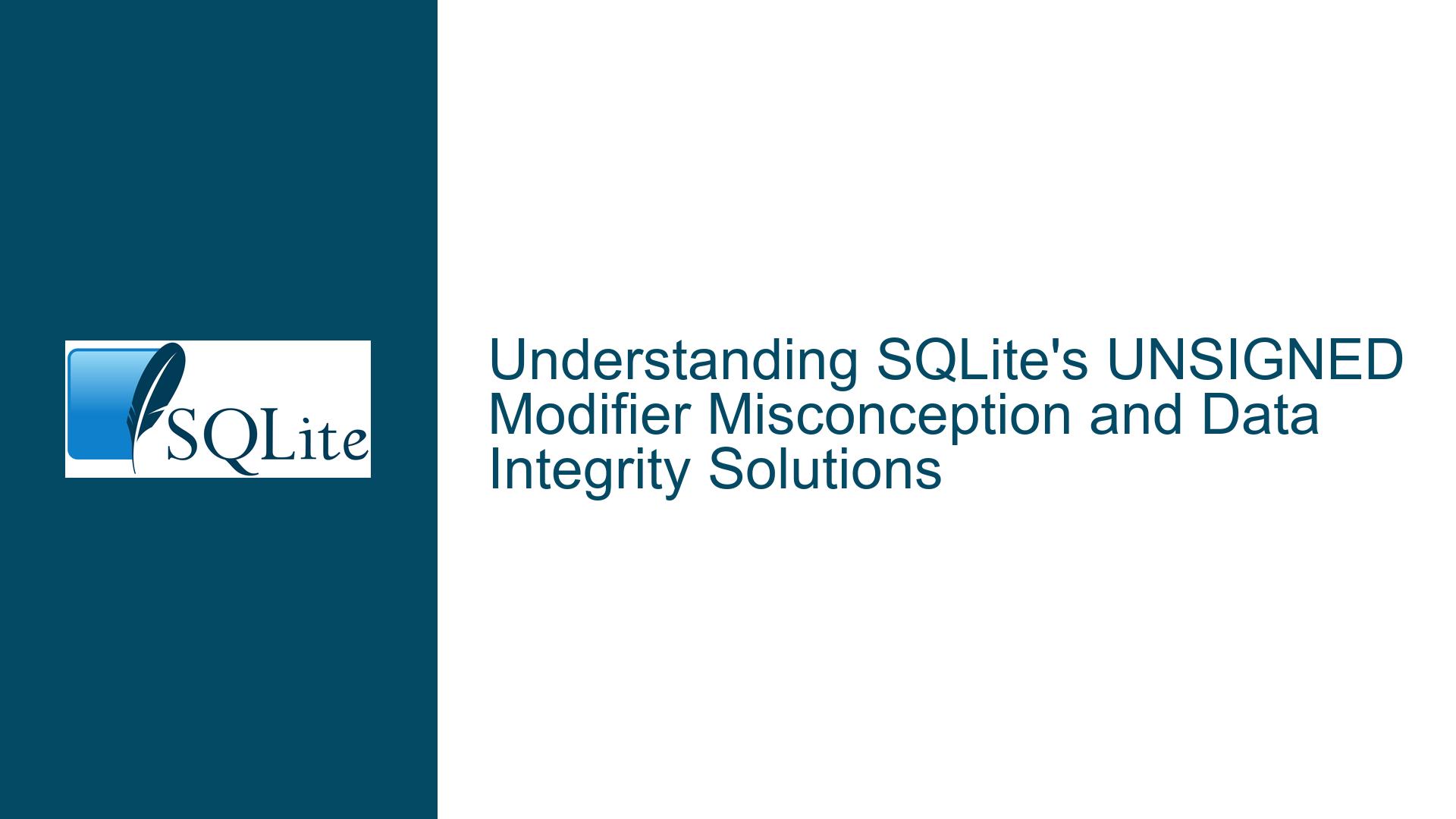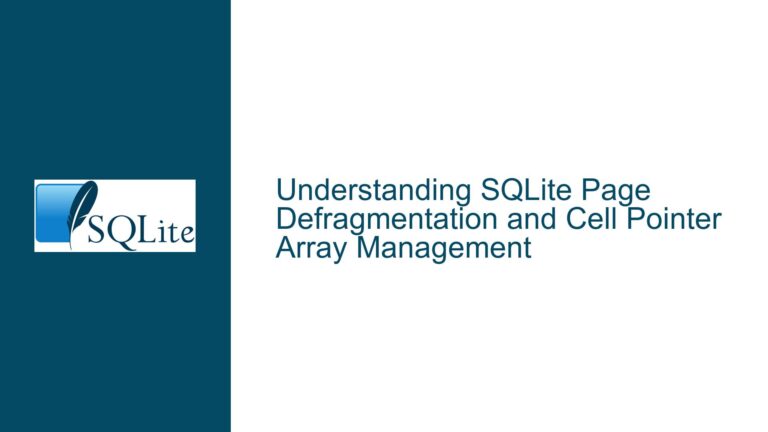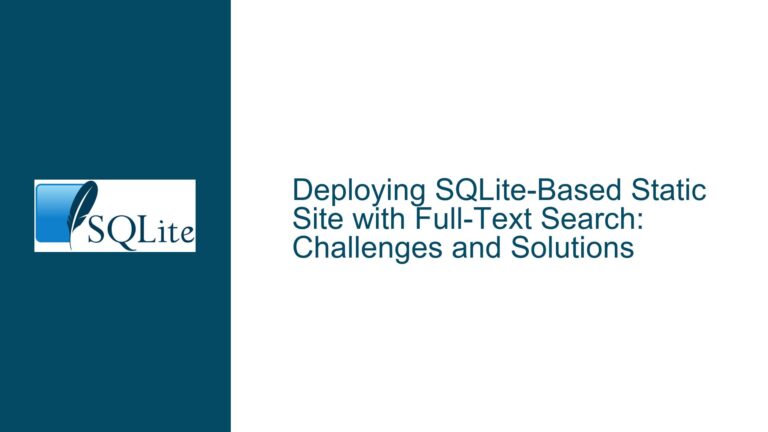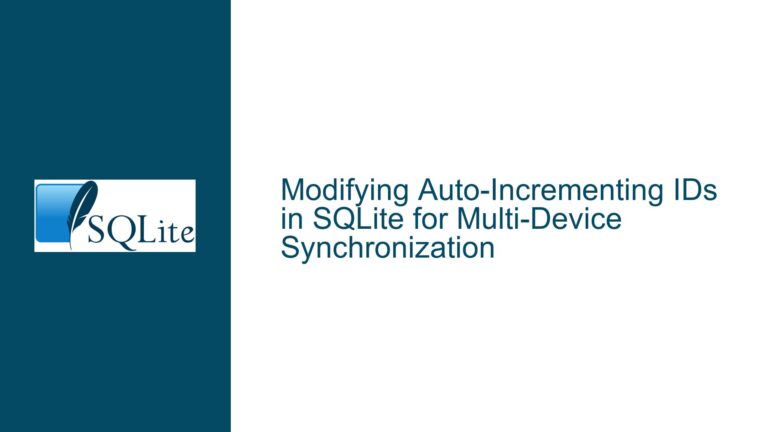SQLite’s UNSIGNED Modifier Misconception and Data Integrity Solutions
The Nature of SQLite’s Type Affinity System and Misleading Syntax
SQLite’s type system is fundamentally different from other database engines due to its dynamic typing and type affinity model. This design allows flexibility in data storage but introduces nuances that can lead to misunderstandings, particularly when developers expect SQLite to enforce traditional data type constraints like unsigned integers. The confusion stems from SQLite’s permissive parsing of type names, which are treated as suggestions rather than strict declarations. For example, a column declared as UNSIGNED BIG INT is parsed for keywords that match predefined affinities (e.g., INT), while modifiers like UNSIGNED are silently ignored. This behavior is intentional but poorly understood, as the documentation emphasizes that SQLite does not validate or enforce type-specific ranges unless explicitly configured to do so via strict tables or constraints.
The absence of native support for unsigned integers in SQLite means that declaring a column with UNSIGNED does not alter its storage class or validation logic. SQLite stores all integer values as signed 64-bit integers, and attempting to mimic unsigned behavior requires explicit application logic or database-level constraints. The example provided in the SQLite documentation (UNSIGNED BIG INT) is not an endorsement of unsigned types but rather an illustration of how type affinity works: any type name containing the substring INT (case-insensitive) assigns INTEGER affinity to the column. This lax parsing allows SQLite to accept a wide variety of type names for compatibility with other SQL dialects, but it does not imply functional equivalence.
Developers migrating from databases like MySQL or PostgreSQL may incorrectly assume that UNSIGNED in SQLite behaves similarly, restricting values to non-negative ranges. However, SQLite’s type system operates at a higher level of abstraction, prioritizing storage efficiency and flexibility over strict type enforcement. This discrepancy often surfaces during schema design, where the lack of runtime checks for unsigned values leads to data integrity issues if not mitigated through alternate means.
Why UNSIGNED Modifiers Fail to Enforce Non-Negative Values
The primary cause of confusion lies in SQLite’s handling of column type declarations. When a column is defined with a type name like UNSIGNED INT, SQLite parses the declaration to determine type affinity but discards any modifiers that do not affect storage class. The parser identifies INT as the relevant substring, assigning INTEGER affinity to the column. The UNSIGNED keyword is treated as a decorative suffix with no semantic meaning. Consequently, inserting negative values into such a column is permitted because SQLite does not associate the UNSIGNED keyword with any validation logic.
Another contributing factor is the documentation’s use of examples that include UNSIGNED BIG INT as a valid type name. While this example is technically accurate in demonstrating type affinity resolution, it inadvertently implies that UNSIGNED has functional significance. New users, especially those familiar with other databases, may misinterpret this as evidence of unsigned integer support. The documentation’s emphasis on SQLite’s "flexible typing" further obscures the absence of runtime checks for modifiers like UNSIGNED.
A deeper issue is SQLite’s historical design philosophy, which prioritizes simplicity and minimal configuration. Unlike systems that enforce strict type constraints by default, SQLite delegates data validation to the application layer or explicit constraints. This approach reduces overhead but shifts responsibility to developers to implement safeguards. When combined with SQLite’s lenient parsing of type names, this can create a false sense of security, as seen in declarations like UNSIGNED REAL (which also has no effect on stored values).
Implementing Data Integrity for Non-Negative Values in SQLite
To enforce non-negative values in SQLite, developers must abandon reliance on non-functional modifiers like UNSIGNED and instead use explicit constraints. The most robust method is a CHECK constraint applied at the column or table level. For example, CREATE TABLE t (a INTEGER CHECK (a >= 0)) ensures that column a only accepts zero or positive integers. This approach is portable, unambiguous, and enforced at the point of data insertion or update. Unlike UNSIGNED, which is silently ignored, CHECK constraints provide immediate feedback during schema creation if misconfigured.
For scenarios requiring stricter type enforcement, SQLite’s strict tables feature (introduced in version 3.37.0) offers an additional layer of validation. Strict tables reject columns with unrecognized type names, preventing accidental use of non-standard modifiers like UNSIGNED. For instance, CREATE TABLE t (a UNSIGNED INT) STRICT will fail with a parse error, alerting the developer to the invalid type name. While strict tables do not directly support unsigned types, they help avoid ambiguities by enforcing the use of standardized type names (e.g., INTEGER, TEXT).
When working with floating-point values (REAL), similar principles apply. SQLite does not distinguish between signed and unsigned floating-point numbers, so a CHECK constraint is necessary to restrict values to a specific range. For example, CREATE TABLE t (b REAL CHECK (b BETWEEN 0.0 AND 100.0)) ensures that column b contains only values within the specified range. This method is both explicit and adaptable to varying precision requirements.
In summary, SQLite’s lack of support for unsigned types necessitates proactive data validation through constraints. Developers should treat UNSIGNED as a historical artifact with no functional significance and instead rely on CHECK constraints, strict tables, or application-layer validation to maintain data integrity. By understanding SQLite’s type affinity system and its limitations, teams can design schemas that are both flexible and robust, avoiding pitfalls associated with implicit assumptions about type modifiers.






